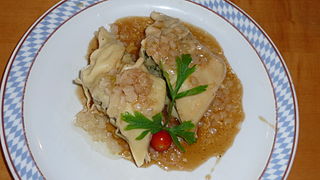
Knödel or Klöße are boiled dumplings commonly found in Central European and East European cuisine. Countries in which their variant of Knödel is popular include Austria, Bosnia, Croatia, Czechia, Germany, Poland, Romania, Serbia, Slovakia and Slovenia. They are also found in Scandinavian, Romanian, northeastern Italian cuisine, Jewish, Ukrainian, Belarusian and cuisines. Usually made from flour, bread or potatoes, they are often served as a side dish, but can also be a dessert such as plum dumplings, or even meat balls in soup. Many varieties and variations exist.

Polish cuisine is a style of food preparation originating in and widely popular in Poland. Due to Poland's history, Polish cuisine has evolved over the centuries to be very eclectic, and shares many similarities with other national cuisines. Polish cooking in other cultures is often referred to as à la polonaise.

Pierogi are filled dumplings made by wrapping unleavened dough around a filling and cooked in boiling water. They are occasionally flavored with a savory or sweet garnish. Typical fillings include potato, cheese, quark, sauerkraut, ground meat, mushrooms, fruits, and/or berries. Savory pierogi are often served with a topping of sour cream, fried onions, or both.

Kroppkaka is a traditional Swedish boiled potato dumpling, most commonly filled with onions and meat. Potatoes, wheat flour, onion, salt and minced meat/pork are common ingredients in kroppkaka. They are very similar to the Norwegian raspeball, Lithuanian cepelinai and German klöße. And quite similar to the Swedish palt and Polish Pyzy.

Boxty is a traditional Irish potato pancake. The dish is mostly associated with the north midlands, north Connacht and southern Ulster, in particular the counties of Leitrim, Mayo, Sligo, Fermanagh, Longford, and Cavan. There are many recipes but all contain finely grated, raw potatoes and all are served fried.

Czech cuisine has both influenced and been influenced by the cuisines of surrounding countries and nations. Many of the cakes and pastries that are popular in Central Europe originated within the Czech lands. Contemporary Czech cuisine is more meat-based than in previous periods; the current abundance of farmable meat has enriched its presence in regional cuisine. Traditionally, meat has been reserved for once-weekly consumption, typically on weekends.

Kalduny or kolduny are dumplings stuffed with meat, mushrooms or other ingredients, made in Belarusian, Lithuanian, and Polish cuisines, akin to the Polish pierogi, Russian pelmeni and the Ukrainian varenyky.

Kopytka are a kind of potato dumpling in Polish, Belarusian, and Lithuanian cuisines. They are similar to Italian gnocchi.
Kluski is a generic Polish name for all kinds of soft, mushy dumplings, usually without a filling.

Chicken and dumplings is a Southern United States dish that consists of a chicken boiled in water, with the resulting chicken broth being used to cook dumplings by boiling. A dumpling—in this context—is a biscuit dough, which is a mixture of flour, shortening, and liquid. The dumplings are either rolled out flat, dropped, or formed into a ball.

Silesian cuisine belongs to the region of Silesia in Central Europe. It is a subtype of Polish and German cuisine with many similarities to and signs of the influence of neighbouring cuisines. The cuisine is particularly renowned for its poppy seed and knödel dishes.

Silesian dumplings are potato dumplings traditional to the wider Silesia region of Poland and Germany. They are also called białe kluski.

Kluski czarne or, also known as kluski polskie or kluski żelazne, are a variety of dumplings popular in Silesia. In addition to minced potatoes and flour, the dough contains also potato starch, which adds to its colour.

A great variety of cassava-based dishes are consumed in the regions where cassava is cultivated. Manihot esculenta is a woody shrub of the spurge family, Euphorbiaceae, native to South America, from Brazil, Paraguay and parts of the Andes.

Swabian cuisine is native to Swabia, a region in southwestern Germany comprising great parts of Württemberg and the Bavarian part of Swabia. Swabian cuisine has a reputation for being rustic, but rich and hearty. Fresh egg pastas, soups, and sausages are among Swabia's best-known types of dishes, and Swabian cuisine tends to require broths or sauces; dishes are rarely "dry".

Dumpling is a broad class of dishes that consist of pieces of cooked dough, often wrapped around a filling. The dough can be based on bread, wheat or other flours, or potatoes, and it may be filled with meat, fish, tofu, cheese, vegetables, or a combination. Dumplings may be prepared using a variety of cooking methods and are found in many world cuisines.

Pampuchy are a type of steamed yeast dumpling (kluski) or doughnut (pączek) in Polish cuisine. A cooked pampuch (sing.) has an oval, flat on the bottom shape, with a bouncy, mushy and soft consistency. Pampuchy or bułki na parze are served hot: either sweet or savoury.

Pierogi leniwe, leniwe - dumplings made of quark, eggs and flour, boiled in lightly salted water. Most frequently served with double/ sour cream, sugar or bespeckled with butter, fried bread crumbs, as well as with sugar and cinnamon.
Lublin cuisine is an umbrella term for all dishes with a specific regional identity belonging to the region of Lublin. It is a subtype of Polish and Galician cuisine with many similarities to and signs of the influence of neighbouring cuisines.



















